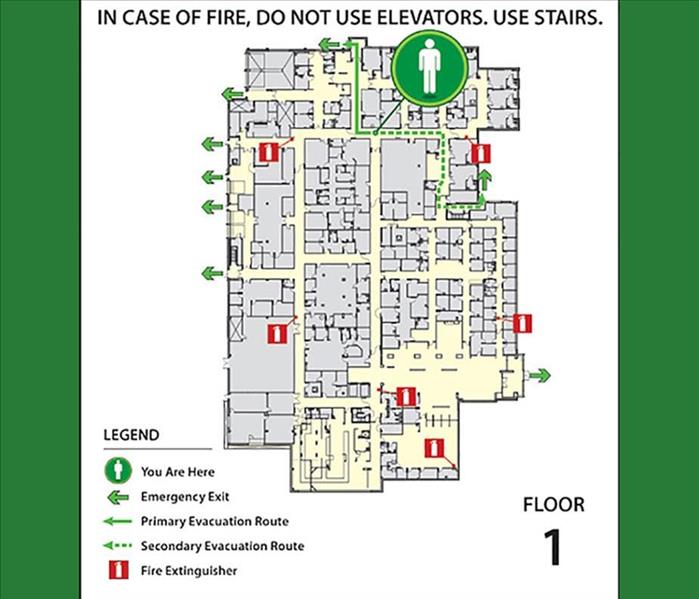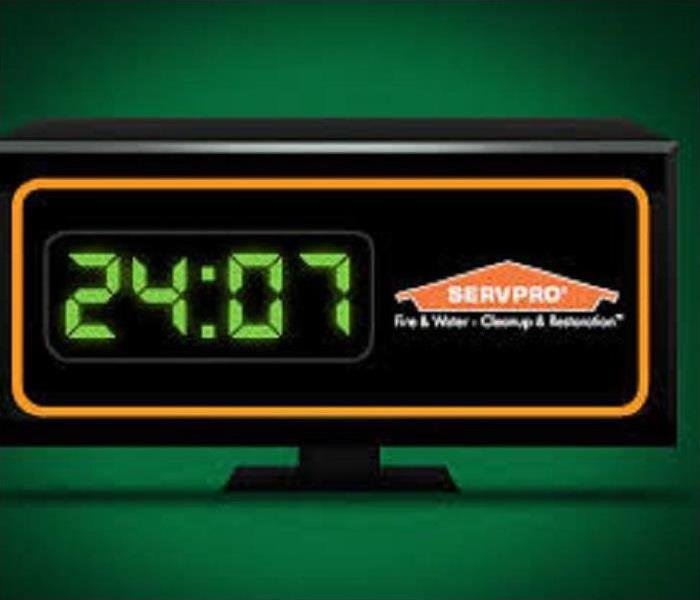Business Water & Fire Damage Preparation
2/20/2024 (Permalink)
 Discover why businesses need an emergency plan to safeguard against water or fire damage. Let us help protect your assets and ensure employee safety.
Discover why businesses need an emergency plan to safeguard against water or fire damage. Let us help protect your assets and ensure employee safety.
In business, unforeseen emergencies like water or fire damage can strike at any moment, leading to devastating consequences if not handled properly. To safeguard their operations, assets and reputations, businesses should have a comprehensive emergency plan in place. In this article, we’ll discuss why such a plan is essential for businesses, focusing specifically on the threats posed by water or fire damage.
There are several advantages to creating an emergency preparedness plan:
- Minimizing downtime – When disaster strikes, time is of the essence. An emergency plan ensures that businesses are well-prepared to handle water and fire damage swiftly and efficiently. By having a step- by-step protocol in place, companies can minimize downtime and promptly resume their operations. A quick response not only helps in maintaining customer satisfaction, but also enables businesses to meet their financial obligations during challenging times.
- Safeguarding assets and investments – water or fire damage can wreak havoc on a business’s physical assets, including inventory, equipment, and infrastructure. A well-structured plan in place ensures that businesses take proactive measures to protect their assets, such as installing fire suppression systems, implementing secure storage protocols, and maintaining appropriate insurance coverage.
- Protecting reputations and customer trust – In today’s interconnected world, a company’s reputation is vital for its long-term success. Failing to address water or fire damage adequately can tarnish a business’s reputation, leading to a loss of customer trust and loyalty. An emergency plan helps companies respond effectively to crises, demonstrating their commitment to customer safety and well-being.
- Ensuring employees’ safety – An emergency plan is not only crucial for protecting assets and reputation but also for ensuring the safety and well-being of employees. Water or fire emergencies pose significant risks to personnel, and a well-structured plan includes evacuation procedures, emergency contact information, and training programs to enhance employee preparedness. By prioritizing employee safety, businesses demonstrate their commitment to their workforce and create a culture of resilience and care.
Summary
The importance of having an emergency plan in place can’t be overstated. By preparing for water or fire damage, businesses can minimize downtime, safeguard their assets and reputation, maintain customer trust, and prioritize employee safety. Proactive measures today can make all the difference in protecting the future of a business when disaster strikes.
SERVPRO of Jacksonville Beach/Ponte Vedra can help you to prepare for the unfortunate event of fire or water damage with their Emergency Ready Plan. With this plan, your business will be able to minimize interruptions because you’ll know what to do and expect if any disaster should strike. We provide full-service water damage restoration services to help you recover from the damage, mitigate the ongoing effects, and get your business back up and running. We have teams that are on call 24 hours a day, 7 days a week to be able to respond to any emergency.
For additional information about the services we offer, visit our website or call us at 904-246-6118.
Common Misconceptions about Mitigation and Restoration
7/5/2017 (Permalink)
 We're on Call, 24/7/365
We're on Call, 24/7/365
Over the years, there has been an abundance of misconceptions and non-truths involving property damage and restoration procedures. Professional restoration companies are trained to see beyond the misconceptions and misinformation that often complicate a claim. If someone doesn’t act quickly enough or doesn’t take the right actions due to these misconceptions, they can end up with even more damage to deal with, that could have easily been avoided.
A SERVPRO of The Beaches/Ponte Vedra professional restoration technician will prioritize mitigation over restoration ensuring damage costs do not escalate. Mitigation is extremely time-critical, as it stops further damage and reduces additional loss. It usually needs to be performed within 24 hours or less. Any delay will further complicate or devalue the mitigation effort.
Restoration, on the other hand, puts the damaged items back to a preloss condition. It is less time-critical, but still important and should be done as quickly as possible.
Misconception #1: Replacing is less expensive than salvaging.
Cleaning is a mitigation process that has excellent results and is cost-effective - especially when compared to the cost of replacement. For instance, when smoke is not properly cleaned from delicate fabrics and surfaces, secondary damage can occur. Replacement is usually the only option. Hundreds of dollars of cleaning can become thousands of dollars of replacement due to delayed action. Today’s restoration professionals are able to effectively clean and remove contaminates, saving expensive replacement costs.
Misconception #2: If you get your carpets cleaned, they get dirty faster.
Techniques, equipment, and materials used in the past to clean carpets were inferior to those used by today’s professionals. In the past, inefficient carpet shampooing left a soap residue that attracted soil more rapidly than prior to cleaning. Restoration professionals now use a cleaning process that both flushes and rinses carpets, and prevents that from happening.
Misconception #3: Once the carpet is dry, that noisy equipment needs to be removed.
The greatest failure in restoring water-damaged structures is to remove the drying equipment before the drying is complete. Using the carpet or padding to determine dryness is a poor misrepresentation of whether the structure is dry or not (and one that is not easily defended if litigation follows). Carpet and padding dry quicker than other structural materials and are not an accurate gauge. The danger with ineffective drying is that it can turn a small loss from water damage into a multi-thousand dollar mold claim. SERVPRO of The Beaches/Ponte Vedra professionals use measuring equipment to determine if moisture content has been returned to normal standards. Meters and sensors are used to document and record the data that justifies the use of the equipment and the best time to remove it. That is extremely important to accomplish the end result - a totally dry structure.
Misconception #4: Once a structure has been damaged by fire, it will always smell like smoke. So why rush to clean it up?
Stories arise about smoke damage restoration efforts that have failed - usually because odor remains. Smoke odor and residue are the products of incomplete combustion. They are acidic and are far more damaging than ordinary dirt or dust. Prompt cleaning actions can reduce losses if this acid is removed or neutralized. Odor removal is more complicated than turning on one machine and hoping to achieve satisfactory results. Restoration for smoke odor has to be thorough. All contaminated areas need to be cleaned, deodorized, and sealed where applicable. It is important that all odor molecules are neutralized, either airborne or absorbed.
SERVPRO of The Beaches/Ponte Vedra professionals are the best assurance when it comes to mitigation and restoration. Due to their continuous technical training, they do not repeat the erroneous theories and mistakes of the past. Using the latest equipment and techniques, they make sure that the job is done correctly and completely - the first time. SERVPRO of The Beaches/Ponte Vedra restoration services are available 24/7, 365 days per year; they include water and flood damage cleanup, mold remediation, odor control, reconstruction services, trauma cleanup, and fire and smoke damage cleanup. Don’t wait another moment if your home has been devastated; call us today at 904-246-6118.
 Discover why businesses need an emergency plan to safeguard against water or fire damage. Let us help protect your assets and ensure employee safety.
Discover why businesses need an emergency plan to safeguard against water or fire damage. Let us help protect your assets and ensure employee safety.





 24/7 Emergency Service
24/7 Emergency Service